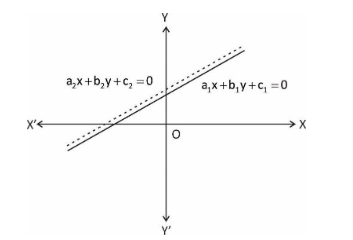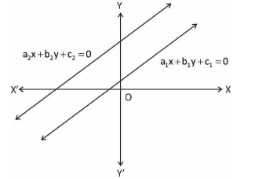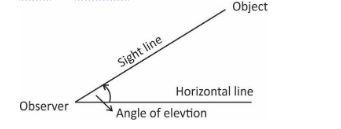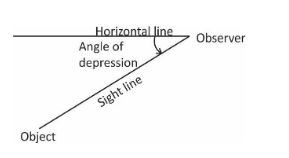
Differentiate between consistent and inconsistent systems. Define angles of elevation and depression.
Answer
559.2k+ views
Hint: To differentiate between consistent and inconsistent systems we can use either numerical way or graphical way. In graphical way, if graphs of given lines meet or intersect somewhere. Then lines are said to be consistent. But, if the graph of lines do not meet anywhere in the plane. Then lines are said to be inconsistent.
In numerical way there are two formulas. If lines satisfy condition $\dfrac{{{a_1}}}{{{a_2}}} \ne \dfrac{{{b_1}}}{{{b_2}}}$then liens will be consistent and if they satisfy condition$\dfrac{{{a_1}}}{{{a_2}}} = \dfrac{{{b_1}}}{{{b_2}}} \ne \dfrac{{{c_1}}}{{{c_2}}}$. Then lines will be inconsistent.
Complete step by step solution:
Let a pair of linear equations in two variable as:
\[{a_1}x + {b_1}y + {c_1} = 0\] and
\[{a_2}x + {b_2}y + {c_2} = 0\]
We can find the solution to these equations by graphical or algebraic method.
Consistent system
By drawing the graph of these two lines, following cases are possible:
(i) If both the lines intersect at a point, then there exists a unique solution to the pair of linear equations. So the pair of linear equations is said to be consistent
Lines intersect at point \[P\left( {x,\,\,y} \right)\]
Point P(x, y) represent unique solution
Algebraically, if \[\dfrac{{{a_1}}}{{{a_2}}}\,\, \ne \,\,\dfrac{{{b_1}}}{{{b_2}}}\] the linear equation is consistent.
(ii) If the lines of a pair of linear equations coincide with each other, then there exist infinitely many solutions since a line consists of infinite points. The pair of linear equations said to be consistent.
Algebraically,\[\dfrac{{{a_1}}}{{{a_2}}} = \dfrac{{{b_1}}}{{{b_2}}} = \dfrac{{{c_1}}}{{{c_2}}}\]the pair of linear equation said to be consistent.

Inconsistent system
Consider the equations
\[{a_1}x + {b_1}y + {c_1} = 0\] and
\[{a_2}x + {b_2}y + {c_2} = 0\]
Let both the lines are parallel to each other, then there exist No solution because the lines never intersect

Algebraically, for such a case
\[\dfrac{{{a_1}}}{{{a_2}}} = \dfrac{{{b_1}}}{{{b_2}}} \ne \dfrac{{{c_1}}}{{{c_2}}}\]
The pair of linear equations in the variables is said to be inconsistent.
Angle of elevation:
The term angle of elevation denotes the angle from the horizontal upward to an object. An observer's line of sight would be above the horizontal.

Angle of depression:
The term angle of depression denotes the angle from the horizontal downward to an object. An observer’s line of sight would be below the horizontal.

Note: The angle of elevation is when you are measuring the angle from the floor or the ground, and the angle of depression is when you are measuring from a ceiling. The only time the two angles are equal is if the ceiling and floor are parallel with each other. If you know your angle terms these are opposite interior angles.
In numerical way there are two formulas. If lines satisfy condition $\dfrac{{{a_1}}}{{{a_2}}} \ne \dfrac{{{b_1}}}{{{b_2}}}$then liens will be consistent and if they satisfy condition$\dfrac{{{a_1}}}{{{a_2}}} = \dfrac{{{b_1}}}{{{b_2}}} \ne \dfrac{{{c_1}}}{{{c_2}}}$. Then lines will be inconsistent.
Complete step by step solution:
Let a pair of linear equations in two variable as:
\[{a_1}x + {b_1}y + {c_1} = 0\] and
\[{a_2}x + {b_2}y + {c_2} = 0\]
We can find the solution to these equations by graphical or algebraic method.
Consistent system
By drawing the graph of these two lines, following cases are possible:
(i) If both the lines intersect at a point, then there exists a unique solution to the pair of linear equations. So the pair of linear equations is said to be consistent
Lines intersect at point \[P\left( {x,\,\,y} \right)\]
Point P(x, y) represent unique solution
Algebraically, if \[\dfrac{{{a_1}}}{{{a_2}}}\,\, \ne \,\,\dfrac{{{b_1}}}{{{b_2}}}\] the linear equation is consistent.
(ii) If the lines of a pair of linear equations coincide with each other, then there exist infinitely many solutions since a line consists of infinite points. The pair of linear equations said to be consistent.
Algebraically,\[\dfrac{{{a_1}}}{{{a_2}}} = \dfrac{{{b_1}}}{{{b_2}}} = \dfrac{{{c_1}}}{{{c_2}}}\]the pair of linear equation said to be consistent.

Inconsistent system
Consider the equations
\[{a_1}x + {b_1}y + {c_1} = 0\] and
\[{a_2}x + {b_2}y + {c_2} = 0\]
Let both the lines are parallel to each other, then there exist No solution because the lines never intersect

Algebraically, for such a case
\[\dfrac{{{a_1}}}{{{a_2}}} = \dfrac{{{b_1}}}{{{b_2}}} \ne \dfrac{{{c_1}}}{{{c_2}}}\]
The pair of linear equations in the variables is said to be inconsistent.
Angle of elevation:
The term angle of elevation denotes the angle from the horizontal upward to an object. An observer's line of sight would be above the horizontal.

Angle of depression:
The term angle of depression denotes the angle from the horizontal downward to an object. An observer’s line of sight would be below the horizontal.

Note: The angle of elevation is when you are measuring the angle from the floor or the ground, and the angle of depression is when you are measuring from a ceiling. The only time the two angles are equal is if the ceiling and floor are parallel with each other. If you know your angle terms these are opposite interior angles.
Recently Updated Pages
Master Class 12 Economics: Engaging Questions & Answers for Success

Master Class 12 Maths: Engaging Questions & Answers for Success

Master Class 12 Biology: Engaging Questions & Answers for Success

Master Class 12 Physics: Engaging Questions & Answers for Success

Master Class 8 Maths: Engaging Questions & Answers for Success

Class 8 Question and Answer - Your Ultimate Solutions Guide

Trending doubts
What is meant by exothermic and endothermic reactions class 11 chemistry CBSE

10 examples of friction in our daily life

One Metric ton is equal to kg A 10000 B 1000 C 100 class 11 physics CBSE

1 Quintal is equal to a 110 kg b 10 kg c 100kg d 1000 class 11 physics CBSE

Difference Between Prokaryotic Cells and Eukaryotic Cells

What are Quantum numbers Explain the quantum number class 11 chemistry CBSE




